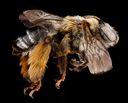Common Long-horned Bee
Melissodes communis
Classification
- Phylum: Arthropoda
- Subphylum: Hexapoda
- Class: Insecta
- Order: Hymenoptera
- Family: Apidae
- Subfamily: Apinae
- Tribe: Eucerini
- Genus: Melissodes
- Species: communis
Pronunciation
How to pronounce Melissodes communis: /mɛˈlɪsoʊˌdiːz kəˈmjuːnɪs/
These audio files are automatically generated. While they are not always 100% accurate, they are a good starting point.
Images






Summary
Melissodes communis, known as the common long-horned bee, is vital for pollination in North American and Central American ecosystems, distinguished by its long antennae and affinity for diverse flowering plants.
Physical Characteristics
Melissodes communis has long antennae and can vary in coloration, typically exhibiting a mix of shades that may include yellow and brown.
Identification Tips
Look for the elongated antennae which are a signature feature of long-horned bees. Males have longer antennae compared to females.
Habitat
Commonly found in various habitats including meadows, gardens, and agricultural areas, especially where flowering plants are abundant.
Distribution
Present in Central America and North America, often observed in regions with rich floral resources.
Diet
Melissodes communis primarily feeds on nectar and pollen from a variety of flowering plants.
Life Cycle
Life cycle consists of egg, larva, pupa, and adult stages. The duration of each stage can vary based on environmental conditions.
Reproduction
Reproduces sexually, with females constructing nests in the ground or in other suitable substrates.
Predators
Predators include birds and other insects that may prey on bee species.
Ecosystem Role
Plays a crucial role in pollination of plants, contributing to biodiversity and ecosystem health.
Collecting Methods
- Netting during active hours
- Ground sampling in nesting sites
Preservation Methods
- Freezing
- Drying specimens
Evolution
Part of the Apidae family, with adaptations that support their role as pollinators in various ecosystems, including specialized forms for different floral types.
Misconceptions
Often confused with other species of bees, particularly those in the same family; they are not aggressive and rarely sting unless provoked.
Tags
- bee
- pollinator
- Apidae
- apinae
- Eucerini
- hymenoptera